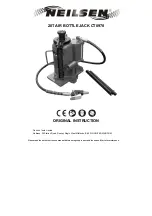
4
OPERATION
Lifting
1. Follow the vehicle manufacturer’s recommended guidelines for lifting. Engage the emergency brake and chock
each unlifted wheel in both directions to prevent inadvertent vehicle movement.
2. Close the release valve by turning the handle clockwise until firm resistance is felt.
3. Refer to the vehicle manufacturer owner’s manual to locate approved lifting points on the vehicle. Center jack
saddle under lift point.
4. Verify lift point, then pump handle to contact lift point. To lift, pump handle until load reaches desired height.
5. Transfer the load to appropriately rated jack stands.
Lowering
WARNING:
Clear all tools and personnel before lowering vehicle. Open release valve slowly. The further
the pump handle is turned counter-clockwise, the faster the load will descend. Maintain control of load at all
times.
1. Raise load high enough to clear the jack stands.
2. Remove jack stands carefully (
always
used in pairs).
3. Slowly turn the handle counter-clockwise, but no more than 1/2 full turn.
If the load fails to lower:
a. Use another jack to raise the vehicle high enough to reinstall jack stands.
b. Remove the malfunctioning jack and then the jack stands.
c. Use the functioning jack to lower the vehicle.
4. After removing jack from under the vehicle, fully lower the saddle to reduce ram exposure to rust and contamination.
MAINTENANCE
NOTICE:
Use premium quality hydraulic jack oil. Avoid mixing different types of fluid and do not use brake fluid,
turbine oil, transmission fluid, motor oil or glycerin. Improper fluid can cause premature failure of the jack and the
potential for sudden and immediate loss of load.
Adding oil
1. With saddle fully lowered set jack in its upright, level position. Remove oil filler plug.
2.
Fill with oil until ~3/16" above the inner cylinder as seen from the oil filler hole. Reinstall the oil filler plug.
Changing oil
For best performance and longest life, replace the complete fluid supply at least once per year.
1. With saddle fully lowered, remove the oil filler plug.
2. Lay the jack on its side and drain the fluid into a suitable container.
NOTICE:
Dispose of hydraulic fluid in accordance with local environmental regulations.
3. Fill with oil until ~3/16" above the inner cylinder as seen from the oil filler hole. Reinstall oil filler plug.
Lubrication
A periodic coating of light lubricating oil to pivot points, axles and hinges will help to prevent rust and assure that
wheels, casters and pump assemblies move freely.
Cleaning
Periodically check the pump piston and ram for signs of rust or corrosion. Clean as needed and wipe with an oily cloth.
NOTICE:
Do not use sandpaper or abrasive material on ram and pump piston surfaces.
Storage
When not in use, store the jack with saddle fully lowered.
!


























